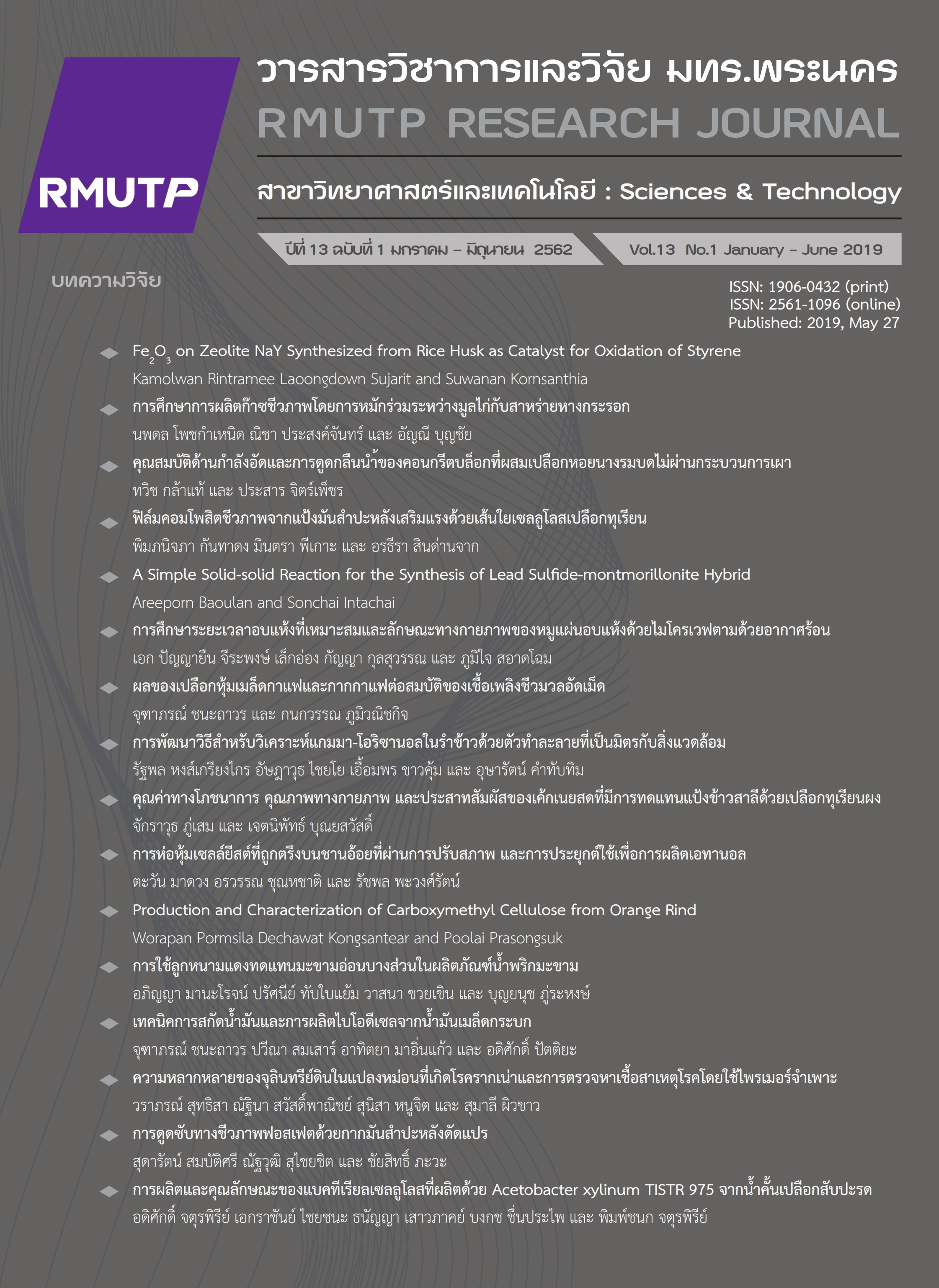Biogas Production Potential from Co-digestion Chicken Waste and Hydrilla (Hydrilla verticillata (L.f.) Royle)
Main Article Content
Abstract
This work presented the production of biogas using anaerobic co-digestion between hydrilla verticillata (HV) from Songkhla Lake Basin and chicken manure (CM). From the study of compositions of both wastes, it was found that the COD of CM and HV were 11,200 and 14,400 mg/l and pH were 6.5 and 5.5, respectively. The biogas production using anaerobic single-digestion of untreated hydrilla verticillata (UHV) gave accumulative methane of 1,251 ml-CH4/g-VS and methane production of 78.28 L-CH4/kg-substrate was obtained. For hydrilla treated with 2% w/v NaOH (THV), the accumulative methane was 1,786 ml-CH4/g-VS and the obtained methane production was 91.87 L- CH4/kg-substrate which was 17.5 % increase when compared to the UHV. For the biogas production using anaerobic single-digestion of CM, it was found that the accumulative methane and methane production were 978 ml-CH4/g-VS and 78.28 L- CH4/kg-substrate, respectively. These were lower than the studies using HV. The study of anaerobic co-digestion of HV and CM at three different ratios; 1:1, 2:1 and 3:1 was studied. It was found that the anaerobic co-digestion using THV and CM at ratio 3:1 and 2:1 gave the highest potential for biogas production. The accumulate methane of 3,202.20 and 2,079.19 ml- CH4/g-VS were obtained, respectively. The methane productions were 2.53 and 82.26 L-CH4/ton-substrate, for ratio 3:1 and 2:1, respectively which is no significant different at 95 % confidence interval.
Article Details
References
[2] The Botanical garden organization. (2018, March 20). Plants Database The Botanical garden organization. [Online]. Available: https://www.qsbg.org/Database/plantdb/searchmix.asp
[3] K. varnishgul, S. Champasri, J. Kulsiri, P. Chantevee and Y. Prasertchai, “Efficiency of hydrilla (hydrilla verticillata) in water quality improvement,” RMUTP Research Journal, vol.9, no.2, pp. 11-18, Sep. 2015.
[4] APHA, AWWA and WPCF, Standard methods for the examination of water and wastewater, American Public Health Association, Washington, DC, 1998.
[5] Morris, “Quantitative determination of carbohydrates with Dreywood’s anthrone reagent,” Science, vol. 107, no.1, pp. 254-255, 1948.
[6] B. G. Miller, “Use of dinitrosalicylic acid reagent for determination of reducing sugar,” Analytical Chemistry, vol. 31, no.3, pp. 426-428, 1959.
[7] A. Sluiter, B. Hames, R. Ruiz, C. Scarlata, J. Sluiter, D. Templeton and D. Crocker, “Determination of Structural Carbohydrates and Lignin in Biomass,” Laboratory Analytical Procedure, vol. 8, pp. 1-15, 2012.
[8] I. Angelidaki, M. Alves, D. Bolzonella, L. Borzacconi, J.L. Campos and A. J. Guwy, “Defining the biomethane potential (BMP) of solid organic wastes and energy crops : a proposed protocol for batch assays,” Water Science & Technology, vol. 59, no.5, pp. 927 – 934, 2009.
[9] N. Sakar, S.K. Ghosh, S. Bennerjee and K. Aikat, “Bioethanol production from agricultural wastes: An Overview,” Renewable Energy, vol. 37, no.1, pp. 19-27, 2012.
[10] C. Wongvan and O. Chavalparit, “Biogas production from co-digestion of pretreated corn stalk and glycerol waste,” Proceedings of the 9th Kasetsart University Kamphaeng Saen Campus Conference: Engineering, Science Technology and Environment, Thailand, 2012, pp. 1837-1844.
[11] W. Tongnu, “Biogas production from mixture of cow dung and hydrilla verticilata as supplementary energy in unsmoked rubber sheet,” M.S. thesis, Dept. Energy. Tech., King Mongkut's Univ., Bangkok, Thailand, 1999.


